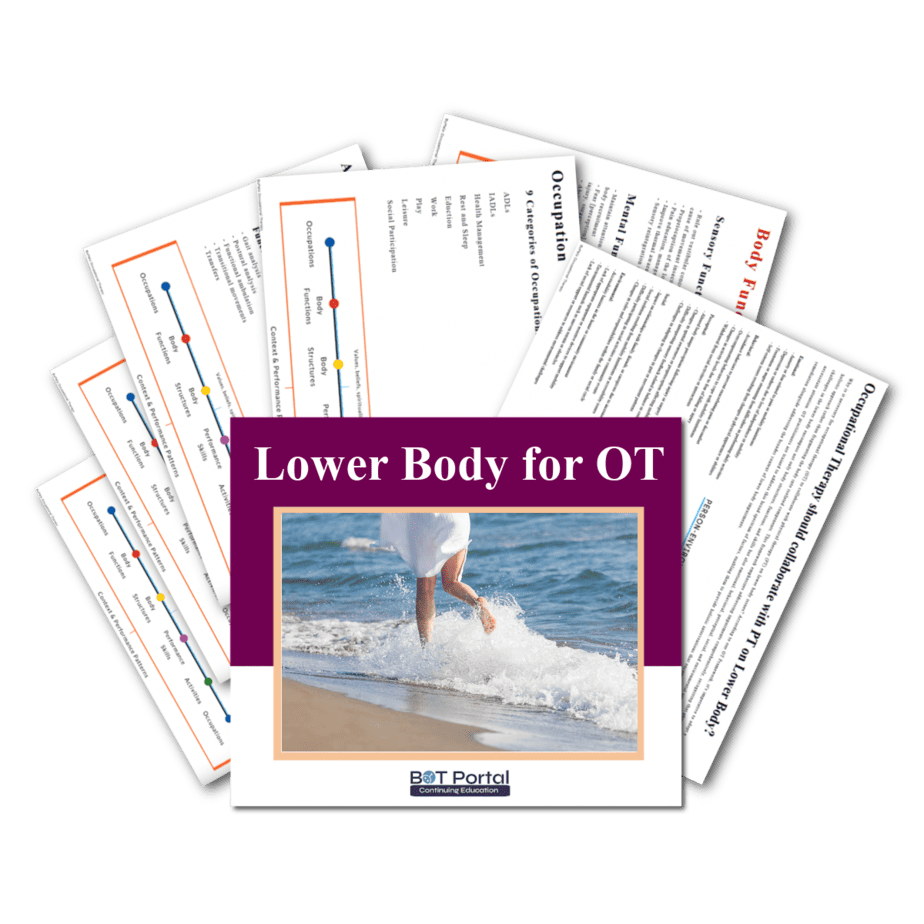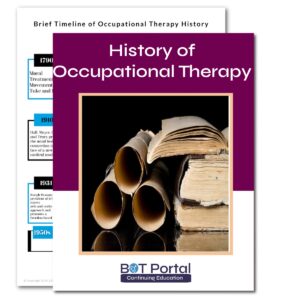Description
Lower Body Rationale for Occupational Therapy
Download the pdf for “Lower Body Rational in Occupational Therapy” to utilize this resource as a tool for your administrators, fellow professionals, and clients. This resource is used during all of our plans of care that require a multi-disciplinary approach to lower body rehabilitation. Occupational Therapy is expansive in their scope of practice and must be utilized to its fullest capacity.
This PDF will help the occupational therapy practitioner:
- Understand why PT and OT are necessary for LB treatment
- Advocate
- Document with language from the OTPF
- Educate patients on the perspective of OT vs PT on the lower body
More information:
Living with lower body impairments goes beyond physical challenges—it encompasses a complex interplay of emotional, behavioral, perceptual, social, and environmental factors. Recognizing and addressing these multifaceted aspects is crucial for promoting holistic well-being and enhancing overall quality of life.
Emotionally, individuals grappling with lower body impairments may experience a range of feelings, from anxiety and depression to frustration and self-esteem issues. The pain, loss of mobility, and changes in physical appearance can take a toll on one’s mental health, affecting their emotional resilience and coping mechanisms. Understanding and addressing these emotional challenges are essential components of comprehensive rehabilitation efforts.
Behaviorally, individuals may adopt various strategies to navigate their daily lives in the face of mobility limitations. This could include avoiding certain activities to prevent exacerbating pain or overcompensating behaviors to cope with decreased mobility. Such behavioral adaptations may impact an individual’s engagement in meaningful activities and their overall quality of life.
Perceptually, changes in body image perceptions and alterations in spatial awareness or proprioception can profoundly affect individuals’ sense of self and their ability to navigate their environment effectively. Difficulty interpreting sensory feedback related to balance or coordination further compounds the challenges faced by those with lower body impairments.
Socially, lower body impairments can disrupt relationships, lead to social isolation, and impact participation in community activities. Changes in roles and responsibilities within the family or social circle may strain interpersonal dynamics, while accessibility barriers in the home or community environment can further limit social engagement.
Environmentally, inadequate accessibility, lack of appropriate equipment, and environmental hazards pose additional challenges for individuals with lower body impairments. Addressing these environmental factors is essential for promoting independence and enhancing participation in daily activities.
Occupational therapists play a vital role in addressing the holistic needs of individuals with lower body impairments. By considering the emotional, behavioral, perceptual, social, and environmental aspects of their condition, occupational therapists can develop personalized interventions that support individuals in achieving their goals and maximizing their quality of life.
- What is included?
- 6 pages of justification broken down by category of activity analysis for an occupational therapy practitioner to better understand how to leverage their skills in a lower body plan of care
Other helpful links:
Check out BOT Portal: Resource Site for Occupational Therapy Students and Practitioners




